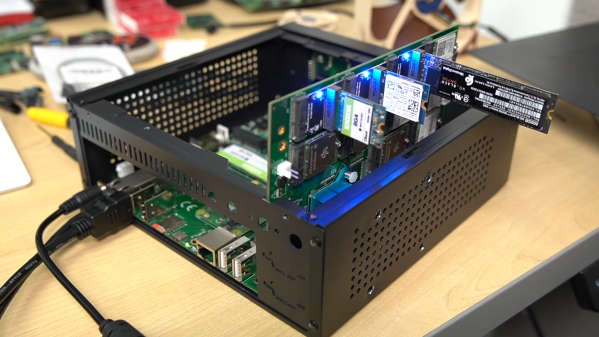The Raspberry Pi now comes in a wide variety of versions. There are tiny little Zeros, and of course the mainstream-sized boards. Then, there’s the latest greatest Compute Module 4, ready to slot on to a carrier board to break out all its IO. The Seaberry is one such design, as demonstrated by [Jeff Geerling], giving the CM4 a Mini ITX formfactor and a ton of IO. (Video embedded after the break.)
The Seaberry sports a full-sized x16 PCI-E port, with only 1x bandwidth but capable of holding full-sized cards. There’s also four mini-PCI-E slots along the top, with four M.2 E-key slots hiding underneath. The board then has a M.2 slot in the middle for NVME drives, and x1 PCI-E slot hanging off the side.
Ports include a USB 2.0, a Cisco-style serial console port, two HDMI ports, and a Gigabit Ethernet jack. Two seperate 12V connectors are provided allowing for a redundant power supply setup, which can be made triple redundant with the addition of the right Power-over-Ethernet hardware. Naturally, the Seaberry also features the usual 40-pin GPIO header, the 14-pin CM4 IO header, as well as the usual DSI, CSI and RTC hookups.
The Mini ITX design is a particular boon. The Seaberry can easily be slapped into a mini PC case, and the power button and activity LEDs work just like you’d expect.
In testing the board, [Jeff Geerling] filled up almost every slot, trying to see how many cards will run on an Compute Module 4 with 8GB of RAM. Throwing in an NVME SSD drive, several Coral TPUs for machine learning, multiple network cards and a SATA interface caused no problems.
Not everything worked due to driver limitations, but everything enumerated on the bus just fine. [Jeff’s] earlier work paid dividends here. His previous attempts trying to get GPUs working on the platform meant opening up an extended BAR space for PCI devices wasn’t a problem.
Further attempts involved adding in a 12-card carrier loaded up with 7 more TPUs, 5 more WiFi cards, and 3 more NVME drives. Outside of some kernel panics from excess NVME drives, the Pi CM4 was still able to detect everything, showing it can address more than 20 PCI-E devices without major issues.
Throwing so many devices at the Pi CM4 may not have an obvious application in the mainstream, but it’s sure to prove useful to someone. We’re certainly enjoying watching [Jeff] push the limits of what’s possible with the CM4, and we hope he gets GPUs working soon.
Continue reading “This Raspberry Pi Mini ITX Board Has Tons Of IO”











